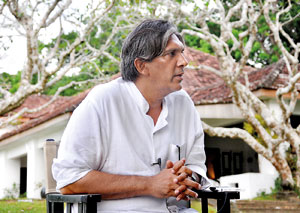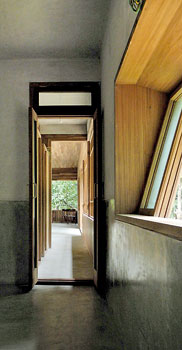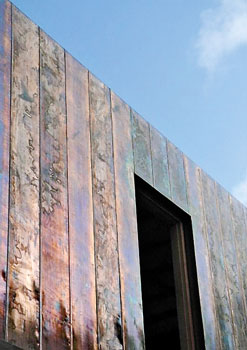In 1996, Bijoy Jain and Geoffrey Bawa met twice in one day, the first time by chance, the second by design. Between those two meetings, Bijoy’s appearance changed dramatically – he had shaved his long hair off completely and was now bald. What Bawa made of the young architect (and his extreme haircut) we don’t know, but Bijoy was delighted to simply be in the company of a man whose work he so respected. “I was a great admirer and had been inspired by his work,” says Bijoy, who included the encounters among the highlights of that vacation.
 |
| At ease in Lunuganga: Bijoy Jain and below, some of his designs.
Pic by Lakshman Gunatileke |
He has been back to the island several times since and has become familiar with the work of many local architects. Here on invitation to deliver the 2012 Geoffrey Bawa Memorial Lecture on Friday May 25, Bijoy is today an accomplished architect in his own right, and one who has found his work deeply influenced by the aesthetic that set Bawa apart.
We sit down with him on a stretch of lawn at Bawa’s garden in Lunuganga, our conversation bordered by the house on one side, and the lake on the other. Born a ‘Mumbaikar,’ Bijoy received his M.Arch. from Washington University in St. Louis, USA and worked in London and Los Angeles before opting for rural idyll in Alibaug, a coastal town close to Mumbai. Bijoy who only flew in on Wednesday morning says he’s still taking it all in. The changes in the landscape remind him of what Bawa shared with him so long ago, over tea and cake. Architecture and landscape, Bawa believed, were in a relationship of ‘continuous attention’ – as one view was obscured, another opened up. “I didn’t fully understand it at that time,” Bijoy admits ruefully.
Now, not only does his own work incorporate some of those ideas, but the landscape in front of us offers its own quiet testimony. “The architecture is really the trees,” Bijoy points out, looking back at the house. He knows Bawa spent years patiently shaping them. “It’s incredible…It’s a kind of giving, not limited to a lifetime. I look at this work as a continuity of that generosity of spirit.” Bawa himself possessed a great simplicity, Bijoy says, sharing his impressions of the man, “He embodied what he created within himself…It [his simplicity] wasn’t with exertion or force, but a natural manner.” Years after Bawa’s passing, Bijoy sees the gardens of Lunuganga as still evolving in a perfect and effortless sympathy with their creator’s vision.
Soft spoken and thoughtful, Bijoy founded Studio Mumbai the year before he met Bawa. The concern continues to be a thriving operation – the staff having grown in number from 7 to over a 100. Their projects cover a wonderful range – from a high-rise in the heart of Mumbai, to a university for women and on to an isolated boutique hotel perched high up in the Himalayas. In 2009, they received international recognition in the form of a Global Award in Sustainable Architecture from the l’Institut Francais d’Architecture and their ‘Palmyra House’ was shortlisted for the 2010 Aga Khan Awards in Architecture. That same year, they exported their workshop, recreating it for the 2010 Venice Biennale. One of the things that made their workspace deserving of that attention, was the studio’s unusual approach to design.
 |
 |
“We’re in a sense a hybrid of architects and guild workers,” says Bijoy. “We have a place or a studio environment where it’s not so much about instructions but where the development of a project is conceived through discussion, storytelling, building of models and objects, all embedded in memories.” His staff include stoneworkers, carpenters and masons, hailing from all over India. Having handily deleted the contractors and middle men from the process, Bijoy approaches each new project as a true collaboration with his team – spending hours in discussion and exploration. “I call myself a sixties child – blue jeans and Jim Morrison – but I grew up in India. My carpenter who is from Rajasthan is quite different. But somewhere there is an overlap, which is what makes us Indian in some way. But it also goes beyond that,” he says.
In India architecture is not the sole province of the educated. “When you’re talking about the built landscape of India, pessimistically I would say 500 million people still build their own buildings, and have nothing to do with architects at all,” says Bijoy, pointing out the abundance of talent and sheer expertise available. Though not formally trained his people bring to each project a certain sensitivity to their environment. “…Their tolerances are very tight. Working with limited resources, they are used to having to get it right the first time.”
The team can (though they sometimes choose not to) engage with every facet of the building – from making the paints applied on the walls to custom building furniture for the interiors. “We’re not dependent on systems this way,” Bijoy says. For him there is also an additional pleasure, this one anthropological in nature. “It’s a way I can understand our country as it moves, as it grows. It’s a window in a sense, or a small laboratory that gives you a sense of what’s happening outside.” |




